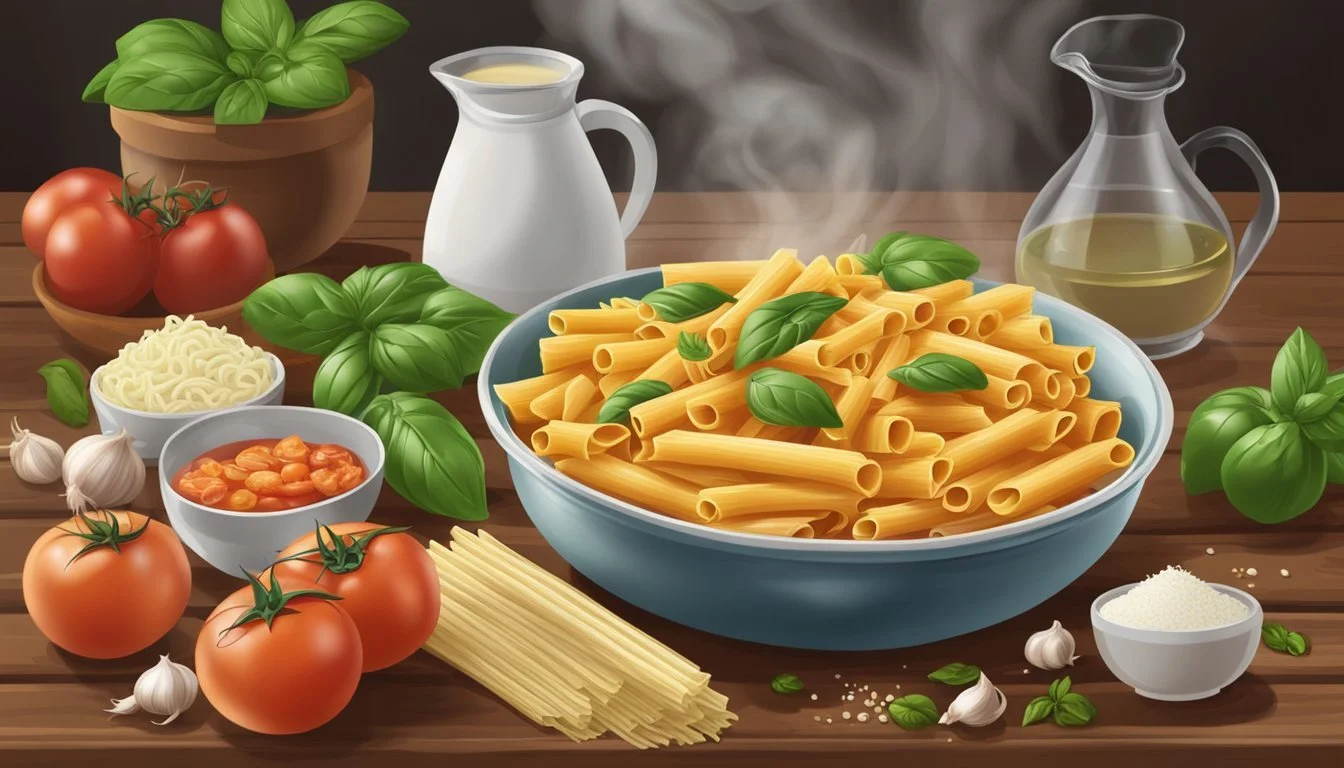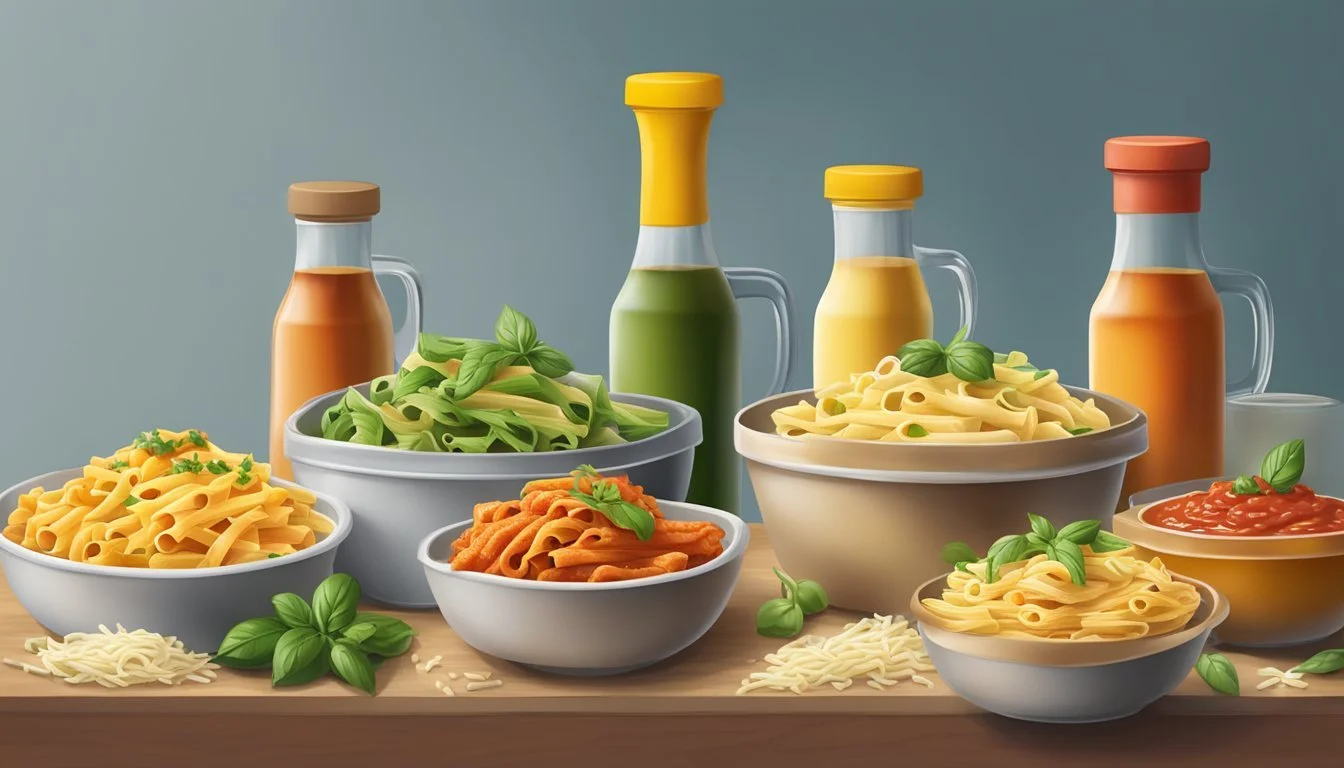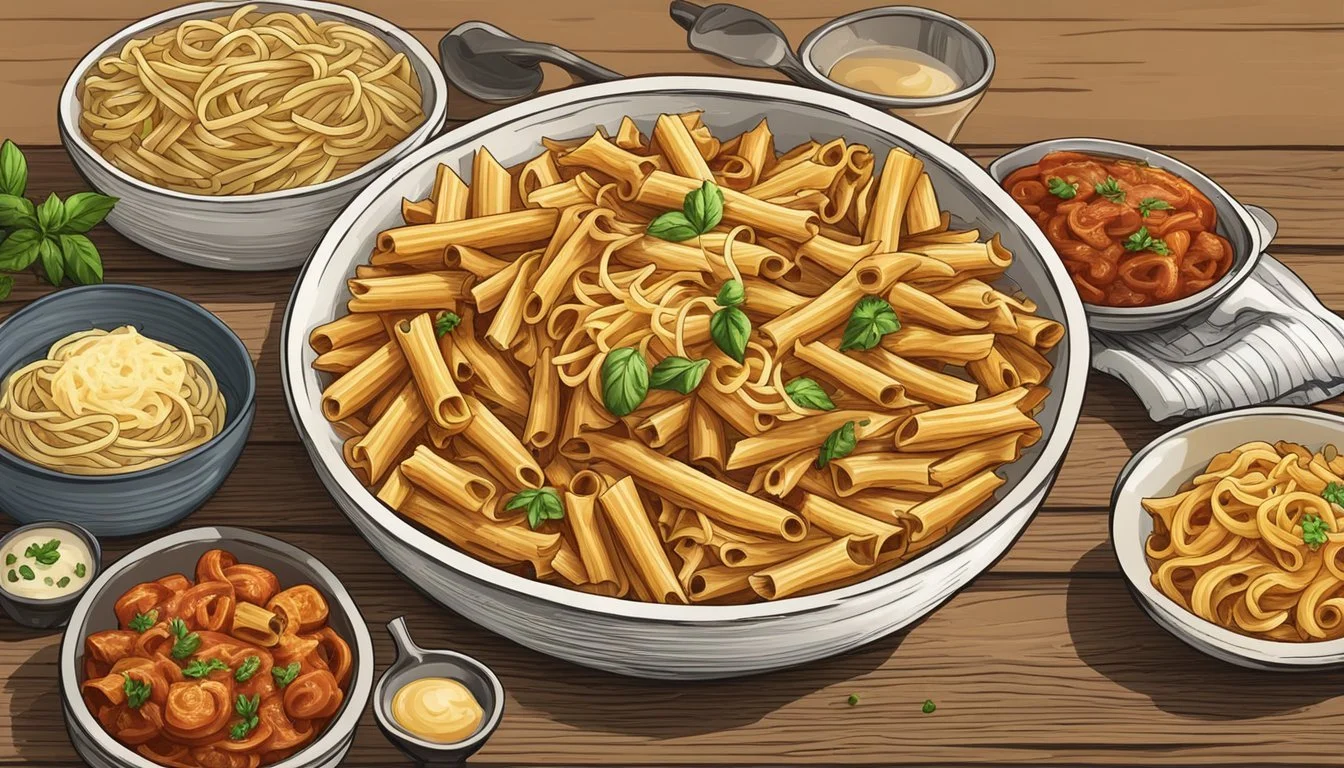Ziti Pasta Substitutes
Top Alternatives for Your Italian Dishes
Ziti pasta is a staple in Italian cuisine, distinctly known for its tube-shaped structure that perfectly holds onto rich sauces and cheese in classic baked dishes. This traditional pasta (What wine goes well with pasta?), while popular in many recipes, may sometimes need to be substituted due to availability issues or a desire to experiment with different textures and flavors in cooking. Understanding the characteristics of ziti pasta is key to finding suitable substitutes that maintain the integrity of the dish.
Substitutes for ziti pasta come in a range of shapes and sizes, each bringing a unique twist to pasta dishes (What wine goes well with pasta dishes?). Common alternatives include penne, rigatoni, and mostaccioli, which share similar characteristics to ziti such as a tubular shape and suitability for baking. Others, like bucatini or elicoidali, offer slight variations in texture and surface area, but can still harmoniously blend in classic recipes calling for ziti. When selecting a substitute, one should consider the cooking time and texture to ensure the pasta complements the sauce and other ingredients used in the dish.
Opting for these alternatives does not compromise the essence of Italian culinary tradition but rather embraces the versatility of pasta dishes. Whether it's in a baked ensemble or a hearty sauce, using substitutes for ziti pasta can yield delicious results that resonate with the comforting and robust flavors Italian cuisine is celebrated for.
Understanding Ziti Pasta
Ziti is a staple of Italian-American cuisine, renowned for its role in hearty dishes like baked ziti.
Characteristics of Ziti
Ziti pasta is traditionally crafted from durum wheat semolina, a hard wheat that maintains pasta's texture and shape during cooking. It is tubular in form, resembling a long tube with a smooth surface, although some variants may have ridges. The dimensions of ziti make it ideal for baking, as its hollow center allows sauces and cheeses to permeate throughout the pasta.
Shape: Tubular, often cut straight, with or without ridges
Texture: Typically smooth, but ridged variations exist to better hold onto sauces
Size: Long, substantial enough to retain structure in baked dishes
Purpose in Dishes
Ziti's design is intentional for baked pasta dishes; its structure adeptly contains and conveys hearty sauces within. In the iconic baked ziti, it's layered with robust tomato or meat sauces and a melange of cheeses, creating a rich and satisfying casserole. This pasta shape's capacity to marry well with a variety of ingredients underlines its relevance in Italian-American cuisine. It's versatile, which also allows for modifications to meet dietary restrictions, including gluten-free alternatives made from various grain substitutes.
Popular Pasta Substitutes
When searching for substitutes for Ziti pasta, several options present themselves as suitable alternatives due to their similar size, shape, and compatibility with a variety of sauces and Italian dishes.
Penne and Penne Pasta
Penne, a tube-shaped pasta with angled ends, closely resembles Ziti in both appearance and function. It's a versatile pasta that works well in baked dishes and with hearty sauces. Penne Rigate, with its ridged surface, is particularly good for holding onto sauces.
Rigatoni
Rigatoni pasta, known for its ridges and larger tubes, serves as an excellent Ziti substitute. Its wider diameter allows for a generous coating of sauce inside and out, making it ideal for robust Italian recipes such as pasta al forno.
Mostaccioli
Mostaccioli are smooth, tube-shaped noodles that closely mimic Ziti in texture and are a fitting swap-in for most dishes. This pasta can be used effectively in casseroles (What wine goes well with casseroles?) and is compatible with a multitude of savory sauces.
Bucatini
Bucatini pasta resembles thick spaghetti but with a hollow center, allowing sauces to permeate the pasta. Although not as commonly used in baked pasta dishes, its shape allows it to be a satisfying alternative when Ziti is unavailable.
Elicoidali
Elicoidali can be differentiated by its helical tube shape, which is similar to Ziti but with a twist. This pasta is particularly good for retaining sauces, and due to its structural integrity, it is an excellent candidate for baked pasta dishes where Ziti would traditionally be used.
Substitutes for Baked Pasta Dishes
Selecting a substitute for ziti in baked pasta dishes requires considering pasta shapes that can hold onto sauces and cheese well and remain al dente even after baking.
Ditali and Ditalini
Ditali and ditalini are small, tubular pasta forms that can be excellent for baked dishes where small, consistent pasta shapes are needed. Their compact size allows them to maintain an al dente texture, essential for a satisfying baked pasta dish.
Sedani
Sedani, resembling celery stalks, are apt for substituting ziti in casseroles and other baked pasta dishes. Their ridges and hollow shape make them perfect for absorbing sauces and melding flavors with ricotta, mozzarella, and parmesan cheeses in baked dishes.
Macaroni and Cheese Alternatives
Elbow Macaroni: A classic choice for macaroni and cheese casseroles, elbow macaroni's curve traps cheese sauce efficiently.
Baked Penne: Penne's larger size captures creamy sauces well, making it a hearty alternative in mac and cheese recipes.
Baked Penne Considerations
When substituting penne in place of ziti, especially in classics like baked ziti, consider the similar tube-like shape that holds cheese and sauce. Penne, when baked with mozarella and ricotta cheeses, as well as meat or vegetables, can mimic the texture and taste profile sought after in traditional baked ziti or lasagna-type dishes.
Vegetable-Based Alternatives
Vegetable-based pasta alternatives offer a nutritious twist to traditional Italian dishes, catering to those with dietary restrictions or seeking a more fiber-rich option. They present a gluten-free solution rich in vitamins while maintaining a delightful texture reminiscent of pasta.
Zucchini Noodles and Spiralizer Options
Zucchini noodles, often termed zoodles, are a popular staple for those seeking a pasta substitute. Made using a spiralizer, they take on a spiral shape that resembles spaghetti and can hold a light sauce efficiently. Zucchini is not only gluten-free; it is also low in calories and offers a substantial fiber boost. Zoodles can be sautéed briefly and incorporated into pasta salads or served with traditional sauces.
Eggplant Slices
Eggplant slices can be cut to mimic the broad, rigid surface of noodles like rigatoni. The vegetable's meaty texture holds up well to baking and can be layered in dishes such as lasagna. Eggplant is a gluten-free option and serves as a hearty base for robust Italian sauces, providing a satisfying taste and an additional serving of vegetables in your meal.
Spaghetti Squash As Pasta
Spaghetti squash is a low-calorie and fiber-rich alternative to traditional pasta. When cooked, its flesh pulls apart into strings that resemble spaghetti noodles, hence its name. It can serve as a bed for a variety of sauces and works exceptionally well in baked Italian dishes. Spaghetti squash is gluten-free and its subtle sweetness pairs nicely with both vegetables like spinach and broccoli, and with heartier meat sauces.
Grain-Based and Other Substitutes
When exploring grain-based alternatives to traditional ziti pasta made from durum wheat semolina, it's essential to consider factors like dietary restrictions, texture, and how these substitutes hold up in popular dishes like casseroles. The following sections detail various grain-based and other substitute options that are high in fiber and offer gluten-free solutions, while also ensuring a satisfying culinary experience.
Quinoa and Other Grains
Quinoa (What wine goes well with quinoa?) is heralded for its nutritional profile, including its high protein and fiber content. Substitutes for ziti pasta incorporating quinoa involve blends of this ancient grain with other ingredients, such as brown rice, to mimic the texture of traditional pasta. Other grains like barley and farro can also serve as substitutes but have distinctive flavors and may alter the pasta dish's final taste. They are suitable in recipes where a firmer texture is desired.
Quinoa-based pasta: Rich in protein and fiber, maintains a firm texture.
Barley: Adds a chewy texture and nutty flavor to dishes.
Farro: Offers a dense and hearty consistency, excellent for robust sauces.
Whole Wheat and Gluten-Free Options
Whole wheat pasta is an excellent ziti substitute, providing a slightly nuttier flavor and an increase in dietary fiber. For individuals with dietary restrictions, gluten-free options made from rice flour, cornflour, or legume-based flours like chickpea provide alternatives without sacrificing the structure needed for pasta dishes such as baked ziti or casseroles.
Whole wheat pasta: High in fiber, closely resembles the classic pasta feel.
Gluten-free alternatives:
Rice flour pasta: Light and slightly sticky, adaptable to various recipes.
Cornflour pasta: Offers firmness with a subtle corn taste.
Legume-based pasta: Typically high in protein and fiber, gluten-free.
Creative Casserole Ingredients
Casseroles are forgiving recipes, allowing for a range of substitutes for ziti pasta. Veggies can take center stage as pasta replacements, with sliced zucchini or eggplant providing a nutritious and lower-carbohydrate base. For a different texture, roasted cauliflower or butternut squash can replace pasta, both absorbing sauces well and contributing a subtle sweetness to the dish.
Zucchini or eggplant: Sliced thin, they provide a pasta-like layering in casseroles.
Cauliflower or butternut squash: When roasted, they add a new flavor dimension and hold up well under sauces.
Pairing Substitutes with Sauces and Ingredients
When selecting a ziti substitute for your dish, it's crucial to consider how the pasta's shape and texture will interact with your chosen sauces and ingredients.
Tomato-Based Sauces
For tomato-based sauces, such as marinara, the ideal pasta substitutes are those that hold sauces well. Penne, with its tube-like shape and ridges, is exceptional when paired with chunky tomato sauces, allowing flavors from herbs like basil and oregano to be captured within the pasta. Additionally, Mostaccioli, similar to penne but without ridges, effectively complements the rich texture of these sauces. An Italian sausage marinara sauce served over penne could provide a satisfying and hearty meal that is high in flavor while maintaining a moderate calorie count.
Creamy and Cheesy Sauces
Moving to creamy and cheesy sauces, one requires pasta that can support the weight and texture of heavier ingredients. Rigatoni, with larger tubes and ridges, pairs exceedingly well with creamy sauces. A baked pasta dish with rigatoni, smothered in a four-cheese sauce and mozzarella topping, allows for an indulgent, gooey bite after baking to golden perfection. For those wanting to replicate a baked ziti dish, Cannelloni can be stuffed with cheese and creamy sauces, providing a similar experience to the traditional Italian cuisine delight.
Olive Oil and Herb Infusions
Simple yet flavorful, olive oil and herb infusions can transform a basic pasta dish into a light, fragrant experience. Bucatini, a thick, spaghetti-like pasta with a hole running through the center, becomes a suitable base for these delicate sauces. The pasta’s structure allows it to absorb olive oil, helping to spread the flavor of ingredients like garlic and basil throughout. Elicoidali, a cousin of penne, can also work beautifully with olive oil-based dressings. If combined with fresh ingredients like cherry tomatoes and basil, these substitutes can emulate the essence of classic Italian cuisine with fewer calories while still satisfying the need for a ziti-like pasta base.
Nutritional Considerations and Benefits
When considering pasta substitutes, it's important to evaluate their nutritional profiles, which can offer a range of health benefits and cater to different dietary needs.
Caloric Content of Different Substitutes
Substitutes for ziti pasta, such as Penne or Rigatoni, offer similar caloric content per serving, making them easy swaps from a calorie perspective. However, whole wheat versions of these substitutes provide a more nutritious alternative with fewer calories and higher nutritional value compared to the refined versions. Cooking pasta to the point of 'al dente', which is slightly undercooked, can help lower the glycemic index of the meal.
Fiber and Vitamin Enrichment
Whole grain pasta substitutes such as Whole Wheat Penne or Mostaccioli contain higher fiber content compared to traditional ziti. Fiber is crucial for digestive health and can help stabilize blood sugar levels. Furthermore, these whole grain options are enriched with vitamins such as B vitamins, which play a significant role in energy metabolism.
Fiber content in whole wheat pasta: Approx. 6g per serving
Vitamin enrichment: B vitamins, including folic acid
Gluten-Free and Allergy-Friendly Options
For individuals with gluten intolerance or celiac disease, gluten-free substitutes like Brown Rice and Quinoa Fusilli are excellent options. These alternatives not only replicate the texture and taste of traditional pasta but also often incorporate additional nutrients such as quinoa, which is rich in protein and essential amino acids.
Gluten-free pasta: Made from brown rice, quinoa, or other gluten-free grains
Health benefits: Suitable for those with gluten-related dietary restrictions, potentially providing a broader spectrum of nutrients
By selecting appropriate ziti pasta substitutes, consumers can tailor their meals to their nutritional needs, whether they are monitoring caloric intake, seeking higher fiber contents, or adhering to gluten-free dietary restrictions.
Conclusion
Choosing a substitute for ziti pasta depends on the Italian dish one is preparing. Pasta substitutes are numerous, but it's important to match the pasta's shape and cooking properties to maintain the integrity of the dish. In baked pasta dishes, like the traditional baked ziti or macaroni and cheese, certain pastas stand out as ideal replacements.
Penne serves as a close alternative, featuring a similar tube shape but with angled ends.
Elicoidali, with its wide, hollow center, works particularly well in capturing sauces.
For heartier recipes, rigatoni presents a robust option due to its larger ridges and diameter, making it suitable for capturing chunky sauces.
The cooking time may slightly differ when using these ziti pasta substitutes, as each one has unique characteristics that affect the way it cooks. When preparing other pasta dishes, such as spaghetti alla carbonara, it is critical to adjust boiling times accordingly to achieve an al dente texture.
When considering pasta dishes that call for ziti, it should be noted that:
Substitute Attribute Ideal Use Penne Angled ends, tube-shaped Baked dishes, casseroles Elicoidali Wide hollow center, long tubes Sauce-heavy dishes Rigatoni Large ridges, hefty diameter Chunky sauce dishes
Seeking the right ziti pasta substitute requires attention to the shape, texture, and sauce pairing capability of the pasta. The suggested alternatives not only maintain the essence of the original dish but can also bring a refreshing twist to your favorite Italian recipes.









